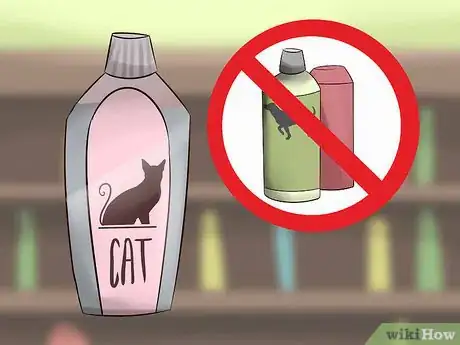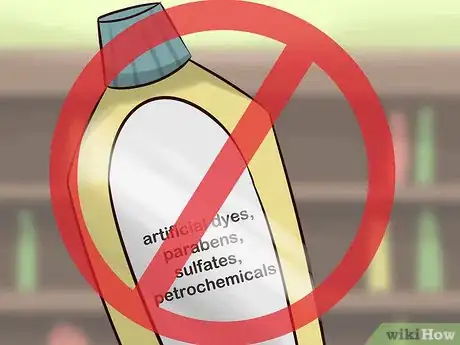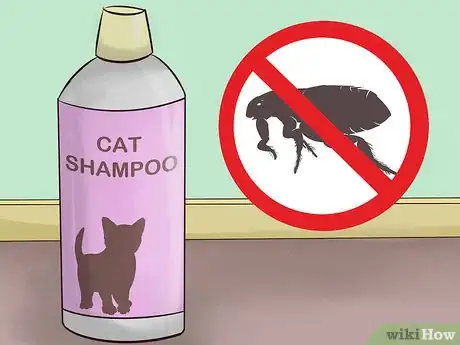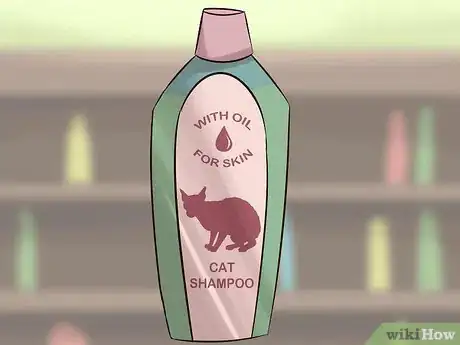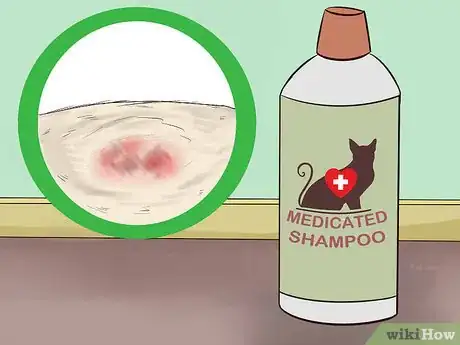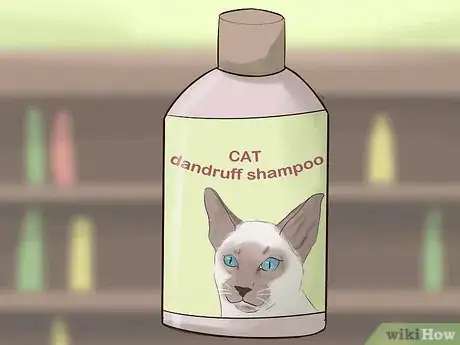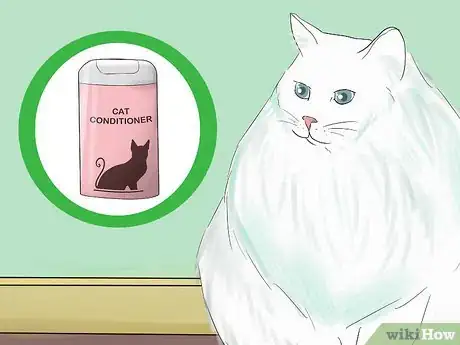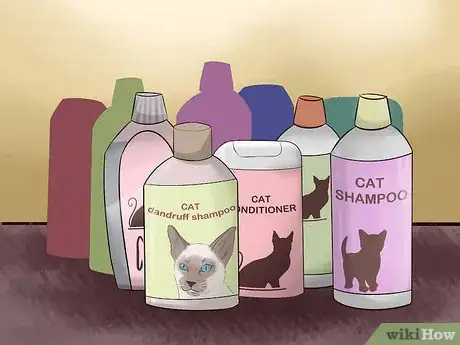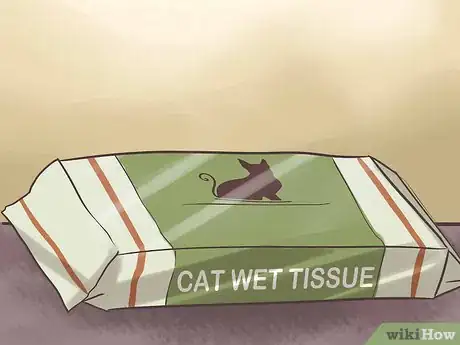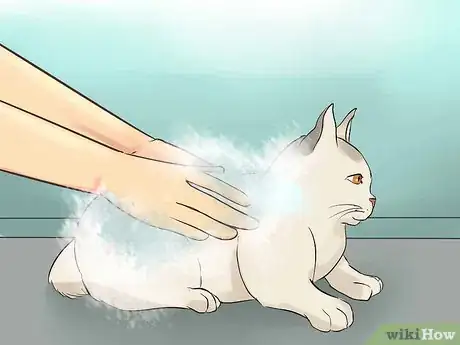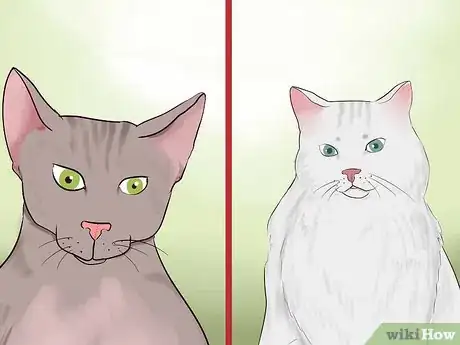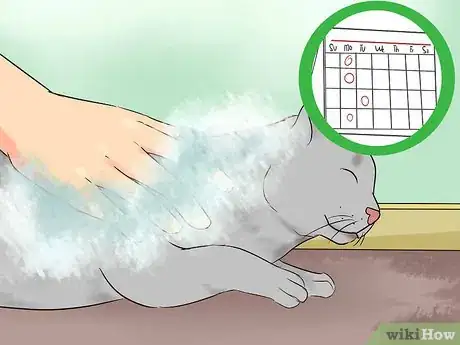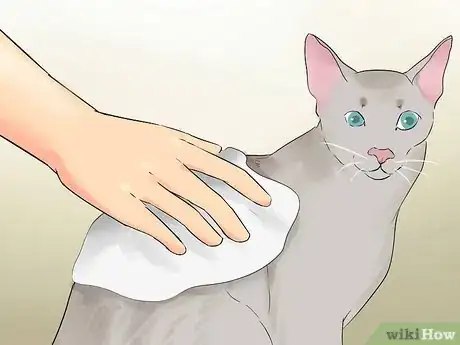This article was co-authored by Lauren Baker, DVM, PhD. Dr. Lauren Baker is a Veterinarian and Assistant Scientist at the University of Wisconsin-Madison. With over 10 years in veterinary medicine, she specializes in the concept of “one health,” which uses insights from veterinary medicine to help human medical research. She holds a Ph.D. in Comparative Biomedical Sciences, a Doctor of Veterinary Medicine, an MS in Comparative Biomedical Sciences, and a Bachelor’s degree in Psychology from the University of Wisconsin-Madison.
There are 15 references cited in this article, which can be found at the bottom of the page.
This article has been viewed 16,801 times.
Cats groom themselves, so you do not need to give them baths very often. However, you may find yourself in a situation where you need to bathe your cat. When you bathe your cat, make sure to use the right shampoo. To choose the right cat shampoo and conditioner, make sure you get a shampoo made for a cat, choose one based on your cat’s skin needs, add a conditioner if your cat has dry skin or a brittle coat, and consider a waterless alternative.
Steps
Identifying the Right Shampoo for Your Cat
-
1Buy a shampoo designed for cats. It is important that you choose a cat shampoo that is made specifically for cats. Don’t use human shampoo or dog shampoo on your cat. Shampoos not made for cats can dry out their skin.[1]
- Human shampoo could also hurt your cat if they groom their fur and the human shampoo has chemicals that are toxic to a cat.
- Human shampoos may also contain harmful dyes and chemicals that can irritate or hurt your cat's skin.[2]
-
2Go for shampoos with simple ingredients. Look for products that have simple ingredients you recognize. This is important because cats groom themselves all the time, which means they will be licking and ingesting whatever is on their coats. You can avoid problems if you know exactly what’s in the shampoo.
- Don’t put stock in labels like “natural” and “organic.” They don’t mean much. Lots of perfectly “natural” ingredients like tea tree oil are toxic to cats and can make them very sick.[3]
- Also remember that just because a shampoo claims it is all-natural doesn’t mean it doesn't contain chemicals. Read the label to double check.
- There are certain instances, like if your cat has a bad case of fleas, that may require shampoos with chemicals. However, talk to your vet before choosing one of these shampoos.
Advertisement -
3Avoid products with artificial dyes, parabens, sulfates, or petrochemicals. Whenever you buy any shampoo, make sure to read the label. There are certain chemicals you should avoid. These chemicals may even show up in products labelled as "natural" or "organic." Don’t buy cat shampoos that contain artificial dyes, parabens, sulfates, or petrochemicals.
- Make sure to read the label before purchasing your cat shampoo.
-
4Get flea shampoo if your cat has fleas. If your cat has fleas and ticks, you can bathe them with a flea and tick shampoo. This can help reduce allergic reactions to bites and kill the fleas on your cat’s body. You can’t use a flea shampoo on kittens that are under six weeks old.[4]
- Flea shampoos are a temporary solution. They get rid of living fleas but do not kill eggs, so they won’t help prevent future outbreaks. There are lots of effective options – talk to your vet about flea other prevention methods.
- Be sure to use flea shampoo designed for cats. Flea shampoos made for dogs can have ingredients that are harmful to cats, even if “natural.”
-
5Consider a special shampoo for skin issues. If your cat has itchy skin, dandruff, irritated skin, or sensitive skin, find a shampoo made to treat these issues. Some shampoos contain ingredients to help soothe your cat’s skin problem.
-
6Try medicated shampoos for skin irritation. If your cat suffers from skin irritation and allergic reactions, you may want to try a medicated shampoo. These shampoos can work to reduce inflammation and redness, along with decreasing the itching.
- Be careful when it comes to ingredients. We often think things like aloe vera, tea tree oil, or chamomile oil as good for soothing skin. But these can actually be toxic for cats.[5] [6]
- If your cat has badly irritated skin, it may have a serious medical issue. Consider talking to a vet about your cat’s skin and how to treat the problem.
Using Conditioner on Your Cat
-
1Avoid products for humans and horses. Conditioners for humans and horses are made to leave some product in the hair. Since cats self-groom (i.e. lick their fur), they can end up ingesting this and getting sick. Only use coat conditioners that are made specifically for cats.
-
2Use a dandruff shampoo to help with coat conditioning. For the most part, cats don't need to use separate conditioners. However, if your cat has dandruff, dry skin, or a brittle coat, a dandruff shampoo may help. This product contains oils and other conditioning agents that will help make the coat softer and add moisture.[7]
-
3Use conditioners on longer-haired cats. You don’t need to use conditioners on short-haired cats. Conditioners are made specifically for cats that have a medium or long coat. They help keep the coat silky, shiny, soft, and free of tangles.[8]
-
4Choose a leave-in conditioner for a silkier coat. If you have a cat with a long coat you'd like to look shinier or silkier, then you can use a leave-in conditioner. To use this product, you spread a small amount of the leave-in conditioner over the coat. Don't rinse it off, but let it soak into the coat.[9]
-
5Consider a combination shampoo and conditioner. Some cat shampoo brands sell formulas that contain both shampoo and conditioner. This may be a good choice if you want to condition your cat's coat at the same time you bathe them.[10]
- A combination formula may help make your cat's fur softer and shinier, help with dry skin, or moisturize a dry, brittle coat.
Choosing Shampoo Alternatives
-
1Try cat wipes. Cat shampoo wipes are a type of bathing alternative you can use on your cat. The wipes have a cleaner on them that you can wipe over your cat’s coat to remove dirt, urine, and other types of debris.[11]
-
2Consider foams. Foams are waterless shampoo products that can clean your cat. You don’t have to get your cat wet and can apply directly to a dry coat. Just use the pump to apply the foam directly onto the cat’s fur. Massage the foam into their coat all over their body, making sure to avoid their eyes.[12]
- Let the foam dry and then brush their coat.
- Read the directions and follow carefully.
-
3Try powder. Powder is another type of waterless cat shampoo. Powders can soak up oils and grease on longer coats. To use powders, sprinkle it over your cat, making sure you don’t get it in the eyes. Massage the powder into the coat all over their body. Then, brush the coat until the powder is absorbed.[13]
- Wash your hands afterwards. You may want to use gloves and apply it outside.
- Read the directions and follow carefully.
- Since cats will try to groom off shampoo and condition, always be sure to choose a kind that is made specially for cats.
Determining When to Bathe Your Cat
-
1Bathe long-haired cats more often than short-haired ones. Cats don’t need to be bathed that often. They generally keep themselves clean. However, long-haired breeds may need to be bathed more regularly than short-haired cats due to the length of their fur.[14]
- This long and silky hair can become greasy if they do not get bathed enough.
-
2Limit how often you bathe your cat. Even if you want to bathe your cat regularly, make sure you don’t bathe them too much. Bathing your cat too often can remove all their natural skin oils, which keeps their coats healthy.[15]
- At the most, you should only bathe your cat once each week.
-
3Choose the right situation for bathing. Sometimes, wiping your cat with a wet cloth or cat wipe may be a better option that bathing them. However, if your cat got into mud or dirt, or if they are have fleas or dandruff, you may need to bathe them. Older cats that have mobility problems may also need bathing more often.[16]
- Some cats can develop skin issues that lead to unpleasant odors or skin irritation that may need to be taken care of by bathing.
-
4Talk to your vet if your cat needs bathing often. If your cat needs bathing often due to certain problems, like allergies or odors, take them to the vet. Your vet may recommend certain types of shampoos specifically for your cat’s problems that won’t dry out or irritate their skin.[17]
References
- ↑ http://pets.webmd.com/cats/bathing-your-cat
- ↑ http://www.embracepetinsurance.com/pet-care/can-i-wash-my-pet-with-human-shampoo
- ↑ https://www.aspca.org/pet-care/animal-poison-control/toxic-and-non-toxic-plants/pet-care/animal-poison-control/toxic-and-non-toxic-plants
- ↑ http://www.vetstreet.com/dr-marty-becker/can-i-use-dog-shampoo-on-my-cat
- ↑ http://www.petpoisonhelpline.com/poison/aloe-vera/
- ↑ http://www.petmd.com/blogs/thedailyvet/ken-tudor/2014/january/tea-tree-oil-safe-pets-31282
- ↑ http://www.petmd.com/dog/grooming/evr_multi_dandruff_free_pet?page=2
- ↑ https://vcahospitals.com/know-your-pet/grooming-and-coat-care-for-your-cat
- ↑ http://www.petplace.com/article/cats/keeping-your-cat-healthy/grooming-skin-care/selecting-the-right-shampoo-or-conditioner-for-cats
- ↑ https://www.care.com/c/stories/6150/choosing-the-purr-fect-cat-shampoo-for-your-k/
- ↑ https://www.vetinfo.com/cat-bathing-without-water-using-cat-bath-wipes.html
- ↑ https://www.drugs.com/vet/hartz-hypoallergenic-shampoo-for-cats-dogs.html
- ↑ https://www.vetinfo.com/waterless-dog-shampoo.html
- ↑ http://www.catological.com/how-to-bath-a-cat/
- ↑ http://www.catological.com/how-to-bath-a-cat/
- ↑ https://www.care.com/c/stories/6150/choosing-the-purr-fect-cat-shampoo-for-your-k/
- ↑ https://vcahospitals.com/know-your-pet/grooming-and-coat-care-for-your-cat
About This Article
To pick the right shampoo and conditioner for your cat, it’s important to look for products with simple ingredients you recognize. Knowing exactly what’s in a shampoo will make it easier to avoid covering your cat’s coat in chemicals, since it will spend a lot of time licking and ingesting whatever is on its fur. Particular chemicals like parabens, sulfates, petrochemicals, and artificial dyes should be avoided. If your cat has itchy skin or other issues, opt for a special shampoo formulated to soothe its skin. For a conditioner, go for a leave-in product to make a long coat silkier and shinier. For more help from our Veterinary co-author, like how to use shampoo alternatives, read on!
